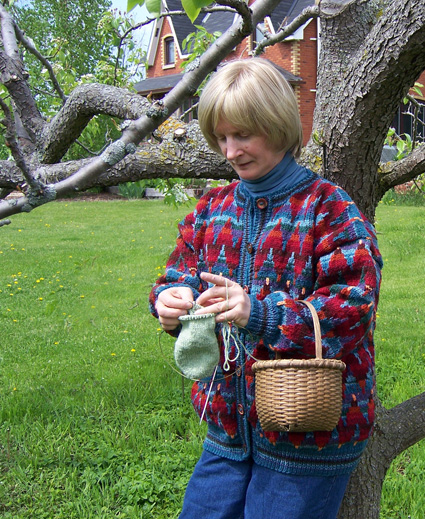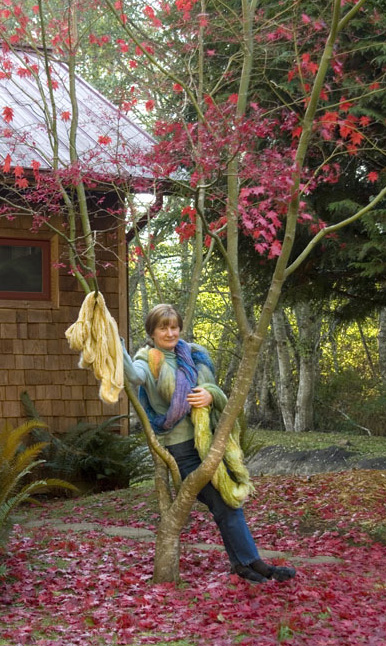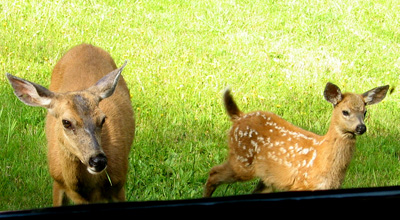Impossible
to describe with mere adjectives, Cat
Bordhi has been knocking the socks off [and knitting
them back on] knitters for years. She's the
author of the hugely popular Socks
Soar on Two Circular Needles and the Magical
Knitting series, featuring
her unique moebius cast on that makes impossible
things possible. I recently got a chance to
ask her things I've always wanted to know about
her.
  Q: You
come up with some of the most innovative
knitting techniques the world has ever seen.
Are you constantly watching over your own
shoulder, noticing these discoveries and
making sure you capture them, like you did
with the New Pathways sock concepts? What
is your process for thinking about knitting
in ways no one has before? Q: You
come up with some of the most innovative
knitting techniques the world has ever seen.
Are you constantly watching over your own
shoulder, noticing these discoveries and
making sure you capture them, like you did
with the New Pathways sock concepts? What
is your process for thinking about knitting
in ways no one has before?
A: Basically,
I love posing questions and figuring things
out. Mostly I get an idea and just dive in
and explore, but sometimes I’m more
methodical. For instance, right now I’m
working on the second book in the New Pathways series,
this one a collection of sock architectures
that do not start at the top or toe, but somewhere
in between. To unearth worthwhile possibilities
I initially used an idea-generation method
inspired by Natalie Goldberg’s book, Writing
Down the Bones. For weeks I asked myself:
What is the stupidest place to start a sock?
The question disarms the limited logical mind
and dislodges an avalanche of answers, some
foolish, others fresh and promising. Those
are the ones I explore. Some turn out to be
dead ends, others suggest alternative avenues,
and a few are gems. And the gems might not
have been discovered with a linear, logical
approach.
While testing ideas, I work
out prototypes with heavy worsted so I can
find out quickly if things work or not, and
do a lot of unraveling. I am not really that
good at predicting what will happen if I do
such and such, so I kind of stumble forward,
closing in on what works. So I am very glad
that knitting unravels so well. Another book
that I’ve used for
decades for innovative idea generation is Conceptual
Blockbusting by James L. Adams. Basically,
the trick is to circumvent the logical mind,
which works almost exclusively with the familiar.
And once something fresh and vital is discovered,
the logical mind can return to help work with
it.
Sometimes, when a design
or technique finally settles into finished
form, there’s a
wonderful kinesthetic sensation of wholeness,
and then I know I’ve followed, rather
than steered, it “home.” My favorite
designs feel to me as if they’ve always
existed, and that I simply remained faithful
to them as I sought them.
Q: Can you tell us
a little about how you developed the Moebius
cast on?
A. Three
influences over three decades led me to develop
the Moebius cast-on and to identify the “road signs” for
knitting along its one-sided pathway.
One came from my experiences as a schoolteacher.
I often used paper Moebii in various configurations
(for instance, giant newspaper Moebius bands
corralling students, which can then be sliced
lengthwise to release new and surprising spaces,
allowing the kids to migrate) to engage my
students, so was familiar with its magical
pathways. This primed me for the second source
of inspiration, an ingenious article by Rita
Buchanan in the Fall 2000 issue of Spin-Off
Magazine with a pattern for a seamless Moebius
scarf (Elizabeth Zimmermann had introduced
a seamed Moebius scarf in 1987). In
Rita’s instructions, the necessary stitches
were cast on and then the needle was coiled
around so the underside could be picked up
and knit into. Her method produced the first
knitted Moebius that displayed the form’s
mysterious characteristics right from the start.
However, I found the picking up to be slow
and painstaking, so I knit one or two and went
on to other projects, storing away in the back
of my mind the possibility and hope of a simpler
and faster way to get set up.
  The remaining influence
had seeded itself in 1973, in the form of
Barbara Walker’s Knitting
From the Top, one of the most intelligent,
practical, and empowering knitting books in
print. She has been my most formative influence,
imprinting on me at a young age that knitting
needed no seams, was continuous, that any shape
or garment was possible if you thought about
how to engineer it, and that unnecessary steps,
once identified, could be eliminated. I was
living on a remote, off-the-grid island near
Canada that winter, and had written to interlibrary
loan for “knitting books.” At the
time few existed and so they sent me 2 or 3,
one of them Barbara Walker’s, which was
newly published. (That first edition was hardcover,
with a generous insert of color pages, everything
modeled by familymembers. Those photos vanished
once it went into soft-cover editions.) The
book cleared up many knitting questions that
had confounded me, and improved my results
immediately. Most of the book is dedicated
to intelligently mapping out strategies for
seamlessly knitting everything from a bikini
to a set-in-sleeve cardigan. One of the many
eye-openers was the “invisible cast-on,” which
Barbara did not invent but certainly described
with more detail than anyone has before or
since. (Today many provisional cast-ons, which
can be worked in both directions, are in common
usage. My favorite is Judy’s Magic Cast-On.)
Barbara’s invisible cast-on used waste
yarn to anchor the loops as they flipped over
and under the needle. Several decades later,
inspired by a new generation of circular needles
with pliant cables, I noticed that the cable
of an extra circular needle could replace the
waste yarn. This meant the stitches would wait
on an operative needle, ready to fly. My two-year
obsession with Moebius knitting started a few
years later when I suddenly realized the invisible
cast-on could use the cable of the same long
circular needle to start a Moebius. This ability
to begin zooming around a Moebius so quickly
made it easy for me to identify Moebius navigation
signals and to experiment with the “rubber
sheet” distortions of this amazing form,
resulting in two collections of designs (Treasury
of Magical Knitting and Second Treasury
of Magical Knitting), ranging from garments
to felted containers with no inside or outside,
yet the grace to safely hold objects. I still
have one ambitious Moebius design waiting in
the wings which I may or may not ever get to. The remaining influence
had seeded itself in 1973, in the form of
Barbara Walker’s Knitting
From the Top, one of the most intelligent,
practical, and empowering knitting books in
print. She has been my most formative influence,
imprinting on me at a young age that knitting
needed no seams, was continuous, that any shape
or garment was possible if you thought about
how to engineer it, and that unnecessary steps,
once identified, could be eliminated. I was
living on a remote, off-the-grid island near
Canada that winter, and had written to interlibrary
loan for “knitting books.” At the
time few existed and so they sent me 2 or 3,
one of them Barbara Walker’s, which was
newly published. (That first edition was hardcover,
with a generous insert of color pages, everything
modeled by familymembers. Those photos vanished
once it went into soft-cover editions.) The
book cleared up many knitting questions that
had confounded me, and improved my results
immediately. Most of the book is dedicated
to intelligently mapping out strategies for
seamlessly knitting everything from a bikini
to a set-in-sleeve cardigan. One of the many
eye-openers was the “invisible cast-on,” which
Barbara did not invent but certainly described
with more detail than anyone has before or
since. (Today many provisional cast-ons, which
can be worked in both directions, are in common
usage. My favorite is Judy’s Magic Cast-On.)
Barbara’s invisible cast-on used waste
yarn to anchor the loops as they flipped over
and under the needle. Several decades later,
inspired by a new generation of circular needles
with pliant cables, I noticed that the cable
of an extra circular needle could replace the
waste yarn. This meant the stitches would wait
on an operative needle, ready to fly. My two-year
obsession with Moebius knitting started a few
years later when I suddenly realized the invisible
cast-on could use the cable of the same long
circular needle to start a Moebius. This ability
to begin zooming around a Moebius so quickly
made it easy for me to identify Moebius navigation
signals and to experiment with the “rubber
sheet” distortions of this amazing form,
resulting in two collections of designs (Treasury
of Magical Knitting and Second Treasury
of Magical Knitting), ranging from garments
to felted containers with no inside or outside,
yet the grace to safely hold objects. I still
have one ambitious Moebius design waiting in
the wings which I may or may not ever get to.
Q: Have any of your
students come up with variations on your
work that surprised even you?
A.Absolutely. One of my
youngest workshop students, at age 10, altered
my pattern for the Lost Trail Cape (in Treasury
of Magical Knitting)
to widen and shape the back of the Moebius
collar like a cap. Witt Pratt designed an ingenious
Moebius bag by eliminating a step in my Moebius
sling bag patterns (see Witt’s Newport
Bag).
And I love receiving emails from readers with
photos showing me how they began with one of
my patterns and veered off to create something
quite different.
Q: Has there ever
been a time that knitting wasn't enjoyable
for you? Tell us about it.
A. Yes – there was a frustrating ten-year
period when every time I started a knitting
project, I’d knit for about half an hour
and then not go back to it for a year. I kept
trying smaller and smaller projects, hoping
if they were small enough I might finish them
and get back into knitting.
Q: What got you back
into knitting again?
A: I finally knit an Aran
sweater for a young friend’s doll. By
some miracle I finished it and that released
me, and I was able to go on to other things
at last! What a relief that was.
Q: Tell us a bit
about your unique visual approach to mathematical
concepts (you mention this in your bio on
your website).
A: People sometimes assume
I must be advanced mathematically but I am
not. I flunked math until I got to geometry
and then suddenly I was an A student, which
really confused me, because I thought I hated
math. Geometry was like candy to me – manipulating,
sliding, rotating and flipping shapes, harvesting
the information revealed through their relationships,
and proving (arguing!) things. I was very fortunate
to have a wise and caring math teacher who
encouraged me. In the small high school I went
to, she was the only math teacher, and in the
remaining two years she more or less coaxed
me into behaving as if I also loved trig and
calculus. I’m very grateful to her. When
I became a schoolteacher, I loved teaching
the magic of math and the kids were very responsive.
Fortunately, I never taught above an eighth
grade level, or I would have begun to stumble.
I firmly believe that math
is delicious when taught in a certain way.
I like to say that numbers are simply little
handles we attach to beauty so we can lift
it up and say, “Look!
This part is bigger than that part!” or “See
how that changes when we do this?” It
is when the numbers are divorced from that
which they represent that they become dry and
dull and intimidating. And much of math is
taught in the form of divorced numbers. So
I always tried to teach with happily married
numbers, united with that which they represented
-- lots of manipulatives, illustrations, charts,
stories, and clear narrative descriptions of
processes. When I began to write knitting books,
I found that my background in teaching math
this way gave me skills for creating clear
knitting patterns, with illustrations, charts,
and clear narrative descriptions that offer
individual knitters several avenues for understanding.
Q: What do you do
for fun/relaxation/amusement when you're
not knitting?
A: Uh -- seriously,
sometimes I ask myself this question and
have no answer, and it worries me. I knit
for work and for pleasure and for fun and
for every other possible reason -- and think
about knitting -- just about all the time
it seems. I do also love to go for solitary
walks through the woods, kayak, and play with
my little grandson, Charlie. I read voraciously,
and love to travel and teach. And I love to
just sit quietly.
  Q: You live on an
island. Tell us about an average day in your
life. Q: You live on an
island. Tell us about an average day in your
life.
A: Mornings I try to start
with a good walk, then work on my current
book until my brain begins to fizzle. Often
during this time deer (our deer have a limited
gene pool and are smaller than the usual
white-tailed deer – on
a neighboring island the deer have evolved
into some strange colors which locals call “buckaloosas”)
appear outside my window. This morning a fawn
was clip-clopping around on my deck inches
away from the window, munching on ferns growing
up through the slats, while its mother grazed
a few feet away. There’s a fox who passes
through my yard sometimes (our foxes are strange
colors, too – no two are alike, and mine
is black with some white spots and rings, while
others are almost like calico cats, and occasionally,
one is the classic fox color), and lots of
birds, including great blue herons, eagles,
and ravens. Then I have lunch and head into
town to get my mail, run errands, stop and
talk to friends (on a small island, friends
appear everywhere), maybe stop at the library
to refresh my book supply, and head home. I
often have my grandson for a few hours in the
afternoon. He is my personal trainer and makes
me go on vigorous stroller hikes and then do
water aerobics as I keep his head above water
while he wiggles around in my sink. Late afternoons
and evenings are for pursuing knitting designs,
revisions, refinements, and so on, recording
everything as I go.
Q: What gives you
the most joy in your own knitting?
A: Not knowing how
something can possibly work and heading in
that direction anyway -- the
thrill of the chase. I also love to zone out
with something simple like one of Elizabeth
Zimmermann’s garter stitch designs or
a Mason-Dixon log cabin blanket.

Q:
What's the one thing most people don't know
about you that you're willing to share with
Knitty readers?
A: When I was young we
lived in a huge old house that had been built
just before the San Francisco earthquake
by the obsessed and eccentric Sarah Winchester,
who built the 160-room Winchester
Mystery House,
now a tourist attraction in San Jose, California.
Our house was much smaller of course (Mrs.
Winchester had built it as a wedding gift for
her niece), but still, everyone who came to
the front door asked how we found our way around.
We weren’t allowed to go on the roof,
so of course we did (there was a door that
opened onto the roof and how were we supposed
to resist that?), and I remember thinking that
I really didn’t know my way around on
the roof, and it was actually a bit scary.
It had so many ups and downs and ins and outs
that it made me feel like I was lost on Mt.
Everest. We also had some of the same fireplaces
and details as Mrs. Winchester’s house,
but fortunately none of the most bizarre features,
like staircases that ended in ceilings or windows
installed in the floor. We never stopped looking
for hidden passageways, but never found any.
One year my father spotted
an ad in the paper offering carpeting at $39.99
per room, installation included, no matter
the size. Our carpets were threadbare, so he
figured he should take full advantage of such
a fine opportunity. The carpet guys nearly
choked when they saw our house with its enormous
rooms, and this was probably when they decided
to balance things out by giving my colorblind
father only one choice of carpeting, which
he agreed to. I don’t
think he consulted my mother. The rather thin
carpet had been woven out of the factory’s
age-old stash of leftover yarns. It was the
equivalent of knitting a blanket out of random
scrap yarns. There were single-line stripes
of one color after the other – no sequence,
just hundreds of different colors, very bright
and a little crazy. We kids (there were 6 of
us) thought it was great for broad-jumping,
because you could start at the door and try
to land on a particular color. And it wasn’t
too long before that carpet was threadbare
too. But we sure had fun. Next time my father
bought better carpet, in the only color he
could see: red. I still don’t know
if he consulted my mother. |

